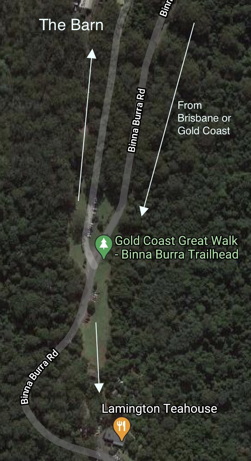plus lunch, interpretive walk, book launch, presentations and discussions
Wednesday 21st October2020
The Barn, Binna Burra
(and via Zoom)
This event took place 21/11/2020
Some of us met for lunch at the Lamington Teahouse near the Binna Burra campground. At 1.00pm activities started with an interpretive walk in rainforest, on the theme “Wildlife interpretation when the wildlife are elusive.” Ronda demonstrated ways of talking about the animals by showing plants they use, evidence of their presence in the area, and using sketches and other props.
We then gathered at the Barn for the Book launch of “Understanding Australia’s Wildlife” by Ronda Green
Steve Noakes (chair of Binna Burra Board of Directors) and Jonathan Fisher (CEO Binna Burra) then talked about Binna Burra‘s emergence from one of the worst disasters a tour business could face to re-opening with some great plans for the future, despite continuing challenges.
Sera Steves (Australian Bat Society and WTA committee member) and Cassie Smith of Oceans 2 Earth then presented “Citizen science and conservation volunteering for domestic tourists: how to get it right when introducing it into your business” followed by discussions
At the AGM the following were elected:
- Ronda Green (chair)
- Maree Kerr (vice-chair)
- Aise Kim (secretary)
- Simin Maleknia (treasurer)
- Leah Burns
- Sera Steves
- Darren Green
- Bill Spence
Binna Burra – one of Australia’s first Ecotourism ventures. Recovery from devastation.
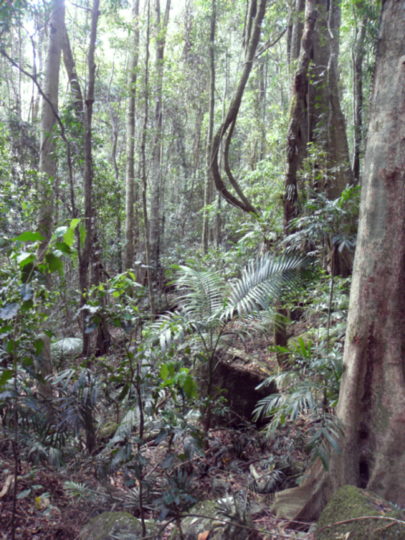
Binna Burra is special. Special because of the vast tracts of rainforest and mountain scenery at is edge and so loved by its founders Arthur Groom and Romeo Lahey. Special because of their vision in the early 1900s of sharing this with others, long before anyone had heard the terms “ecotourism” or “ecolodge”,and the massive efforts that went into creating it. Special because of the wonderful network of walking tracks through Lamington National Park, and she short walks on Binna Burra land, including what I think is the world’s first Brail trail (he Senses Trail) in a rainforest and the self-guided nature trail pamphlets produced by the Lamington Natural History Association. Special because of the on-going dedication and enthusiasm by Arthur Groom’s descendants, its Board members and others who have worked there, and because of their personalities that have made it such a warm, welcoming and thoroughly enjoyable experience for guests. And very special in the memories of so many who have stayed there.
The moment I saw the total destruction of the 83-y-o heritage buildings hit me harder than almost any news item I’ve seen over the decades.
The heritage cabins and lodge and all their contents have gone (except the dinner bell). The spirit of Binna Burra lives on in the many wonderful people who have worked there. The campground has re-opened with new safari tents, as have the upmarket sky lodges, and despite severe financial and other challenges there are great plans for the future.

See:
- https://www.wildlifetourism.org.au/binna-burra-memories-and-hopes/
- https://www.facebook.com/watch/?v=708947946357736
- https://qorf.org.au/binna-burra-road-reopens/
- https://www.binnaburralodge.com.au
Book launch
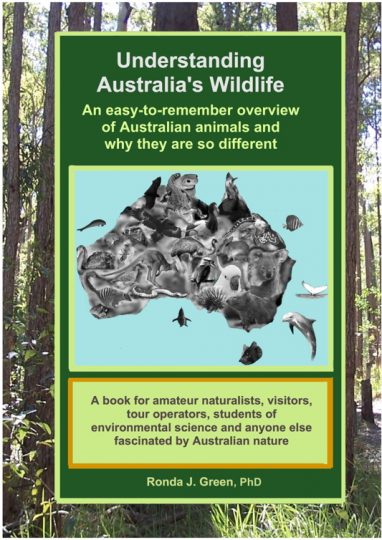
by Ronda Green, Chair of Wildlife tourism Australia
From the preface of Understanding Australia’s Wildlife
This book is for:
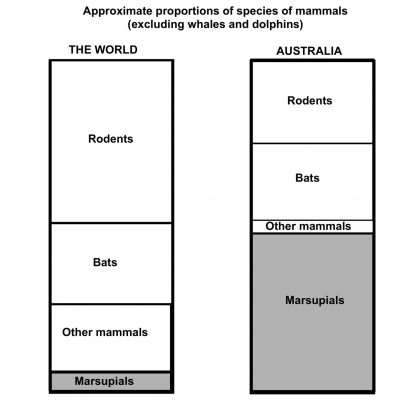
- visitors to Australia interested in our wildlife, and wanting to understand some of the differences between their own home region and the country they are visiting, as well as which animals they might be able to see in the wild or captivity
- Australian residents who want a broader understanding of our country’s wildlife and why it is so different from other world regions environmental science or zoology students and environmental consultants as a checklist of wildlife groups that may be relevant to their projects, tips for remembering them and various other details
It provides:
- a rapid understanding of what is so different about Australia
- easy ways to recall which major groups of animals live here
- some fascinating facts about selected species
- tips on where and how to see our wildlife
- some of the ecological needs of our wildlife and conservation issues they may face
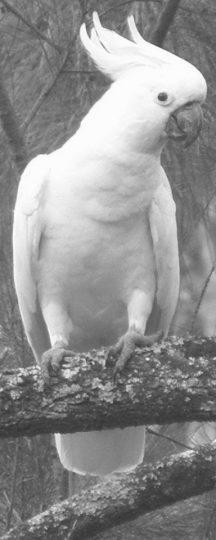
The idea for such a book first came when I was asked to convene a six-month course on Techniques for Wildlife Conservation at the Southern Cross University (Lismore, NSW) some years ago. I could not find, even amongst the plethora of wildlife books available nowadays, an easily-affordable text for my students that gave a clear, readable overview of all groups of Australia’s wildlife … Since then I have run many ecotours which introduce people to Australian wildlife while seeking examples in a variety of habitats, so have modified my writings … for a book we give to each of the guests on our wildlife tours, trying to make it the kind of book I would like to pick up (and have sometimes sought in vain) if visiting another country, something to help me quickly grasp what is different (and special) about that country and the main kinds of wildlife I might expect to see there. It will also be useful for Australian residents wanting to quickly gain a better understanding of their country’s wildlife, including amateur naturalists, students of environmental science, tour operators and anyone else with an interest in understanding our wildlife but lacking the time to wade through too many other texts….This edition is not in colour, since my aim was to make the printed version as affordable for as many as possible, but I intend producing a colour version some time in the future.
Citizen Science and Volunteer Tourism
Covid-19 lockdown has forced many tour operators the world over (including guides and managers of ecolodges and wildlife parks) to re-think how they might conduct their businesses in the future, especially:

- how do we continue the positive aspects of less pressure in natural areas?
- how do we switch from marketing primarily to international guests to attracting more domestic tourists?
Wildlife-loving and general nature-loving tourists often feel a desire to contribute to conservation, including conservation-related research, and many tour operations were started because of the owner’s genuine desire to do the same. thus citizen science and volunteer tourism provide one possible direction for tourism businesses to add to their mix in future plans. But it has to be done well to make a valid contribution to conservation and/or science, and there have been some poor attempts that have produced little more than cynicism.
Sera Steves (Australian Bat Society and WTA committee) will introduce the topic of citizen science in tourism. Cassie Smith of Earth 2 Ocean will present some guidelines on doing it right. Ronda Green (WTA chair) will briefly describe WTA’s wildlife research network
The topics of citizen science and volunteer tourism will then be thrown open for general discussion amongst those attending in person and via Zoom
